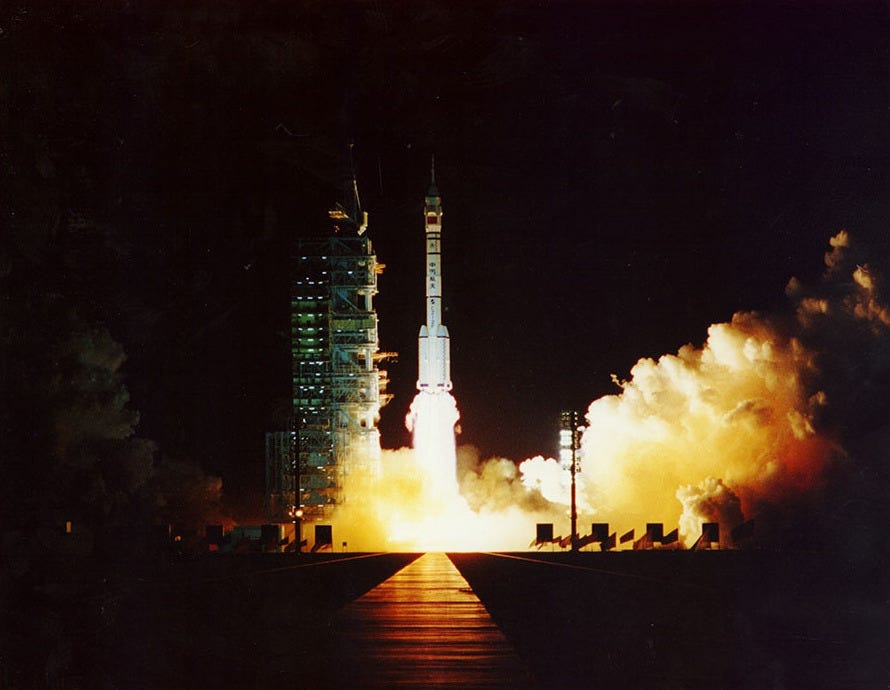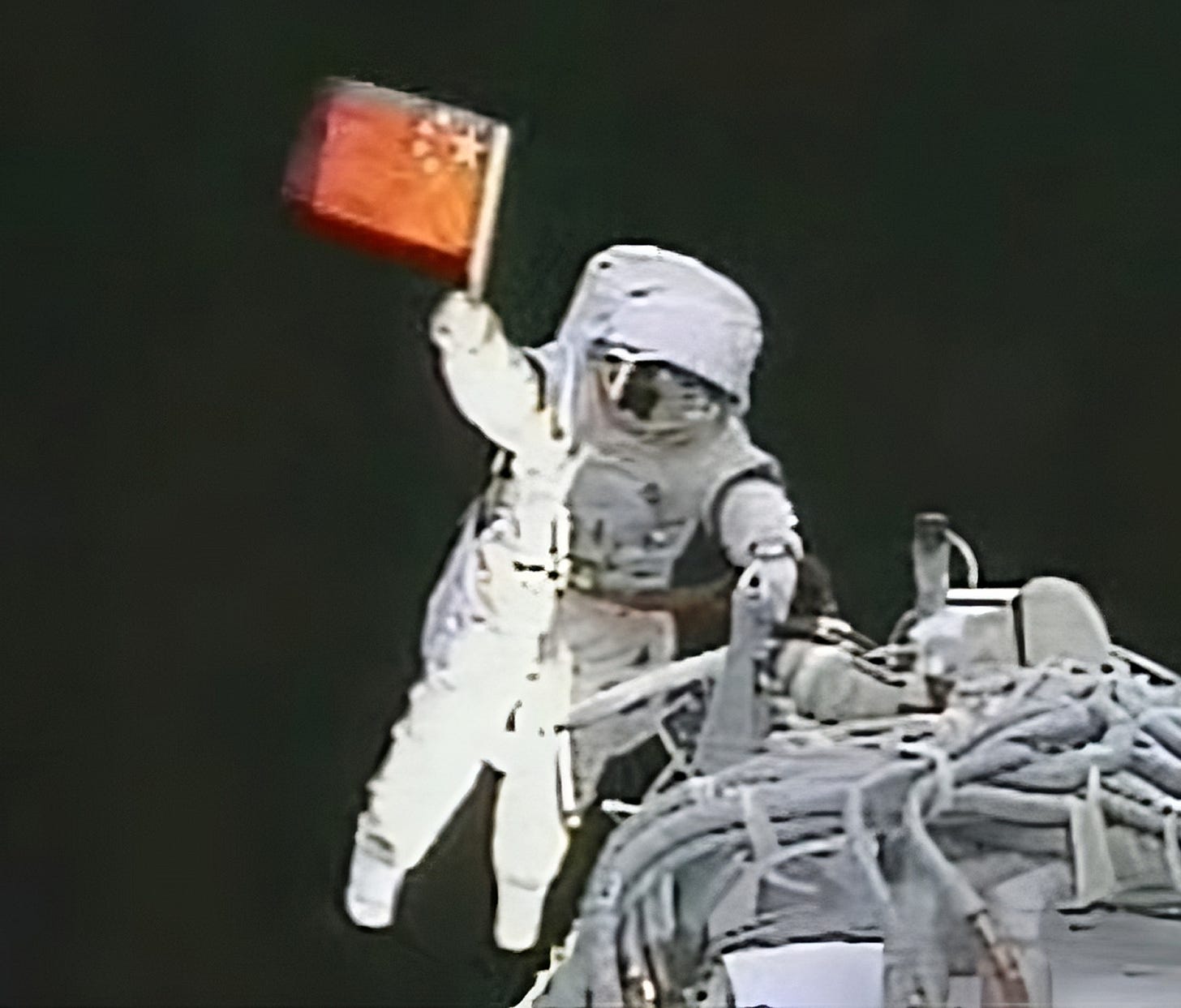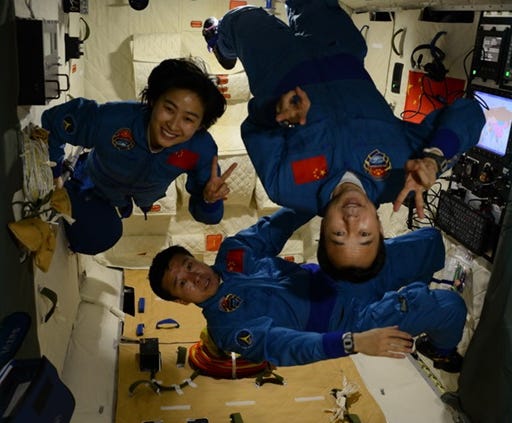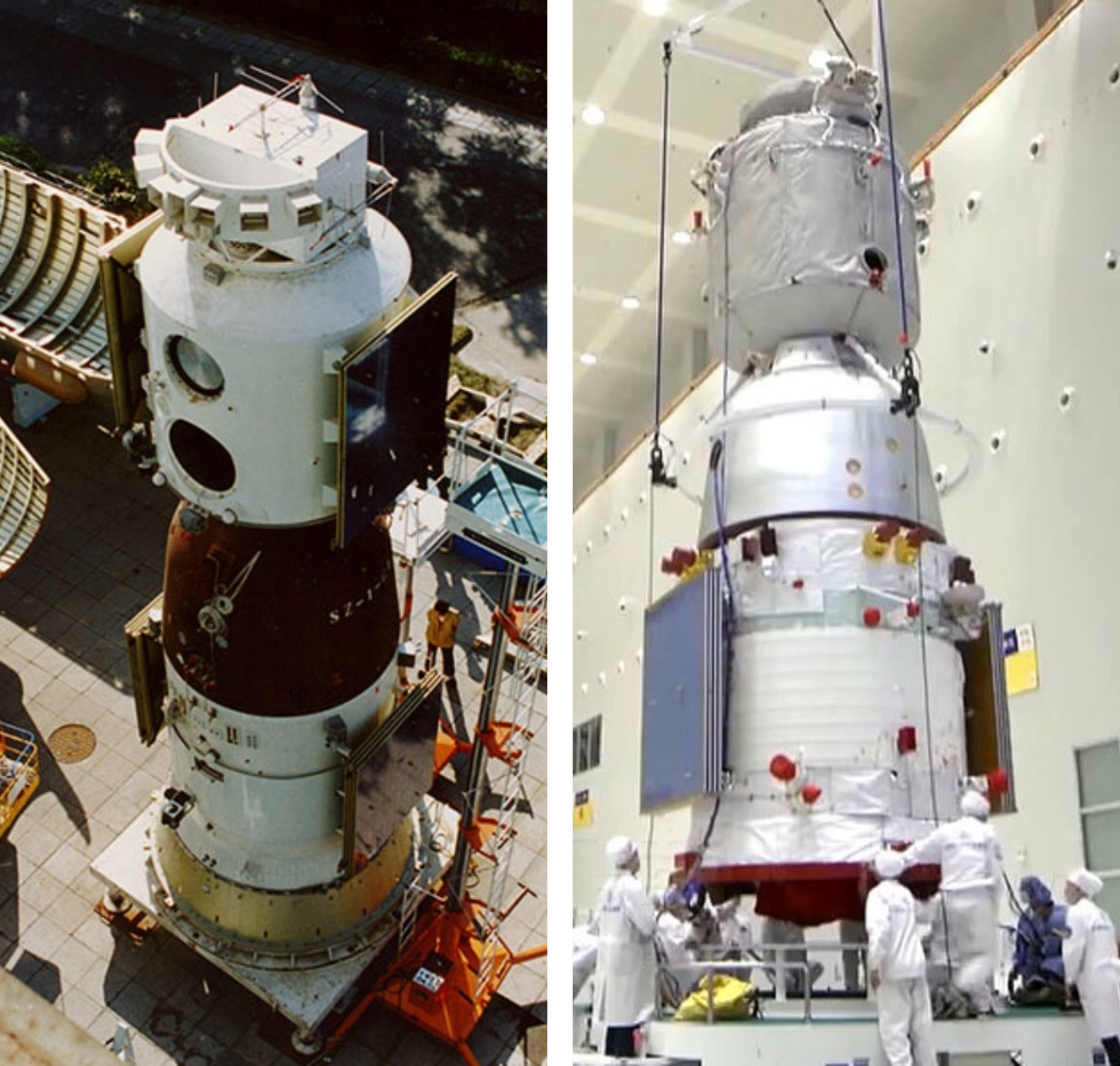Celebrating 25 years of Shenzhou missions!
As of November 20th 2024 China has been performing Shenzhou missions for 25 years.

November 20th 1999 (China Standard Time), twenty-five years ago, China began the Shenzhou-1 mission, the first step towards launching Chinese astronauts, called taikonauts, into orbit and returning them safely.
In the years since China has become one of three nations to safely and routinely fly humans to and from orbit while being the only nation currently operating its own permanently crewed space station. Along with this, the nation has so far flown twenty-four taikonauts to-and-from space, a figure that will greatly increase with lunar missions and space station expansion planned for the coming decade.
Video via Wu Lei on X, formerly Twitter. (Video hosted on YouTube for archival).
The crew currently onboard the Tiangong Space Station, Shenzhou-19 with Cai Xuzhe (蔡旭哲), Wang Haoze (王浩泽), and Song Lingdong (宋令东), celebrated the twenty-fifth anniversary of the Shenzhou-1 mission by sharing the following message:
Cai Xuzhe: “China’s manned mission took the first step from a blueprint to realizing the first space dream laying a solid foundation for realizing the nation’s thousand-year-old dream of flying into space.”
Song Lingdong: “Over the past twenty-five years, generations of Chinese taikonauts have been working hard with confidence and self-reliance, continuously setting new heights for China’s space exploration program, successfully completing the three-step strategic mission and building China’s own space station.”
Wang Haoze: “As one of the new-generation taikonauts in the new era we must inherit our ancestors’ legacy, shoulder the responsibility of making our country strong, stand on the giants’ shoulders to continue climbing, and carry the historical baton of our generation!”
Cai, Wang, and Song: “Never forget your original aspiration, and only then can you accomplish your goals. On this memorable day, we pay tribute to all of the heroes who have dedicated their youth, passion, and even their lives to our country’s space program. The prosperity we enjoy today is as you wished, and the future will be in safe hands!”
To celebrate the twenty-five years since Shenzhou-1, let’s briefly recap each Shenzhou mission thus far!
Project Establishment
September 21st 1992 had China’s central government establish and approve the China Manned Space Program with the goals of launching and returning a crewed spacecraft, rendezvous and docking spacecraft while operating a space laboratory, and operating a long-term modular space station.
The first goal would encompass missions that establish the fundamental capability in human space exploration and space experiments. The second goal would encompass missions that made technological breakthroughs for extravehicular activities, spacecraft rendezvous, and spacecraft docking procedures, along with short-term crewed stays in orbit. The third goal would encompass missions to establish and operate a long-term, permanently crewed, space station.
These goals allowed for the development of the Shenzhou spacecraft, the Feitian extravehicular space suit, the first two Tiangong space stations, and today’s permanently crewed Tiangong Space Station.
Initial Missions
Shenzhou-1
The first mission of the Shenzhou program began at 22:30 pm Universal Coordinated Time on November 19th. This mission aimed to examine the performance and reliability of the Long March 2F launch vehicle in a real-world environment with a Shenzhou spacecraft and evaluate spacecraft technologies, such as the attitude control system and module separation mechanisms.
Atmospheric reentry provided an additional testing environment, where a lifting body reentry was tested, followed by heat shield separation to allow for the first touchdown of a Shenzhou reentry capsule. A total of fourteen orbits would be completed for the first mission, with a total mission duration of 21 hours and 11 minutes. The end of the mission and landing occurred at 19:41 pm Universal Coordinated Time on November 20th.
Shenzhou-2
Shenzhou-2 was the first week-long mission for a Shenzhou spacecraft, lasting from January 9th to January 16th in 2001, for a total duration of 7 days 10 hours 22 minutes. This mission carried a dog, rabbit, and monkey onboard to test life support systems, mice and aquatic animals were also onboard. Various science experiments were performed across the spacecraft’s three modules, including the transmission of prerecorded tapes.
Like the previous mission, Shenzhou-2’s reentry capsule came back through the atmosphere as planned. After reentry however, the capsule parachutes failed to deploy resulting in a hard landing and a small fire, according to Yang Liwei in 2017.
Shenzhou-3
In 2002, lasting between March 25th and April 1st for a total duration of 6 days 18 hours 51 minutes, the Shenzhou-3 mission carried the first human analog onboard a Shenzhou spacecraft. This human analog was a dummy that would simulate the physiological signals of a human. Once again various science experiments were onboard, as well as a camera to transmit images of Earth.
Shenzhou-4
Shenzhou-4 was the final major uncrewed mission, carrying two human analog dummy taikonauts. The mission lasted from December 29th 2002 to January 5th 2003, for a total duration of 6 days 18 hours 36 minutes.
All systems and items needed for a human mission were onboard for the Shenzhou-4 mission, such as systems for manual and emergency landings, as well as medication and food. Tracking ships were also deployed to the South Atlantic, both the North and South Pacific, and the Indian Ocean.
First Crewed Missions
Shenzhou-5

October 15th 2003 is a day that will live on forever in China as it was the first time the nation conducted a human spaceflight mission, becoming the third to do so after the United States and the former Soviet Union. Taikonaut Yang Liwei (楊利偉) flew onboard the Shenzhou-5 spacecraft for the historic mission.
Shenzhou-5 spent 21 hours 22 minutes 45 seconds in orbit, demonstrating China's ability to send humans into orbit and return them safely. During his time in orbit, Yang Liwei ate various meals, took photos looking around and out of the spacecraft, spoke with his family, napped, and monitored how he felt adapting to space for mission controllers.
Following his flight, Yang received the title of 'Space Hero' from then-outgoing paramount leader Jiang Zemin (江泽民), the Gagarin Medal from Russia, and an honorary doctorate from the Chinese University of Hong Kong. Yang Liwei is today working as deputy chief designer of the China Manned Space Engineering Office.
Shenzhou-6
Shenzhou-6 was the first multi-day Shenzhou mission as well as the first to carry two humans, with Fei Junlong (费俊龙) and Nie Haisheng (聂海胜) onboard. The mission lasted from October 12th to October 16th in 2005, for a total duration of 4 days 19 hours 33 minutes.
During their almost five days in space, the crew performed various experiments, moved between the reentry and orbital modules, and celebrated Nie’s forty-first birthday. Many of the experiments were focused on the human experience in microgravity.
Shenzhou-7
The Shenzhou-7 mission was a major human spaceflight mission for China as it saw the first spacewalk by a taikonaut. This spacewalk was performed by Zhai Zhigang (翟志刚) from the orbital module of the Shenzhou-7 spacecraft. Also onboard for the mission were Liu Boming (刘伯明), in a Russian Orlan spacesuit to support Zhai from inside the orbital module, and Jing Haipeng (景海鹏), inside the capsule taking care of the spacecraft. The mission lasted from September 25th to September 28th in 2008, for a duration of 2 days 20 hours 27 minutes.
The primary goal of the Shenzhou-7 mission was to demonstrate the capabilities of the first-generation Feitian space suit by leaving the spacecraft and retiring an experiment that had been running outside. This experiment was a solid lubricant that had been exposed to the vacuum of space for forty hours.
Short-Term Stays
Shenzhou-8
Shenzhou-8 is so far the final uncrewed Shenzhou mission, with it lasting from October 31st to November 17th in 2011. This mission had a Shenzhou spacecraft autonomously dock with the Tiangong-1 space station, launched back on September 29th 2011. Two docking tests were performed during the mission, with Tiangong-1 acting as the passive target. A biological sample experiment from Germany and the European Space Agency was also flown onboard.
Shenzhou-9
The Shenzhou-9 mission to the Tiangong-1 space station was the first time a Chinese woman flew into space, as well as the first repeat flight of a taikonaut, along with the first crew to visit China's first space station. Shenzhou-9's crew were Jing Haipeng (景海鹏), the first repeat flyer, Liu Yang (刘洋), the first Chinese woman in space, and Liu Wang (刘旺).
As mentioned before, the Tiangong-1 space station was launched on September 29th 2011, with the Shenzhou-9 crew launching on the 16th June 2012, and docking on the 18th. While aboard the station for almost eight days, the crew conducted experiments, tested station systems, and performed two docking tests with their Shenzhou spacecraft. The mission ended on June 29th 2012 upon the crews safe return to Earth, for a total mission duration of 12 days 15 hours 25 minutes.
Shenzhou-10
Shernzhou-10 was the second mission to the Tiangong-1 space station, with the crew being Nie Haisheng (聂海胜), Zhang Xiaoguang (张晓光), and Wang Yaping (王亚平), China’s second woman to fly to space. The mission lasted from June 11th to June 16th in 2013, for a total duration of 14 days 14 hours 29 minutes.
While onboard the crew conducted technological and space medicine experiments. Wang Yaping also led a physics lecture from the station, which was broadcast via live television.
Shenzhou-11
The Shenzhou-11 mission was the first month-long mission human spaceflight mission for China, it also carried two crew instead of the usual three. Flying for the mission were Jing Haipeng (景海鹏), who spent his fiftieth birthday in space, and Chen Dong (陈冬).
The goal of the Shenzhou-11 mission was to spend a month in space aboard the Tianong-2 space station, launched back on September 15th 2016, to test life support systems ahead of construction of a permanently crewed space station. Two crew were flown on the mission to extend how long supplies lasted. As such the mission lasted from October 16th to November 18th in 2016, for a duration of 32 days 6 hours 29 minutes.
Early Long-Term Stays
Shenzhou-12
Shenzhou-12 was the first mission to the current Tiangong Space Station, then consisting of the Tianhe core module. Beginning on June 17th 2021 and ending on September 17th 2021 the mission was the first three-month human spaceflight mission for China, for a total duration of 92 days 4 hours 11 minutes.
Flying for Shenzhou-12 were Nie Haisheng (聂海胜), Liu Boming (刘伯明), and Tang Hongbo (汤洪波). While onboard the space station, the crew tested resources recycling, long-term life support systems, and the robotic arm. Two spacewalks were also performed, the first on July 4th by Liu Boming and Tang Hongbo, and the second on August 20th by Nie Haisheng and Liu again.
Shenzhou-13
The Shenzhou-13 mission was China’s first six-month human spaceflight mission, once again flying to the Tiangong Space Station consisting of just the Tianhe core module. The mission lasted from October 15th 2021 to April 16th 2022, for a total duration of 182 days 9 hours 32 minutes.
Onboard the Shenzhou-13 mission was Zhai Zhigang (翟志刚), Wang Yaping (王亚平), and Ye Guangfu (叶光富). During the mission, the crew attended to scientific payloads inside and outside of the station, as well as giving lectures to students in China and the United States. Twp spacewalks were once again conducted, the first on November 7th with Zhai Zhigang and Wang Yaping, making Wang the first Chinese woman to perform a spacewalk, and the second on December 26th with Ye Guangfu and Zhai again.
Shenzhou-14
Shenzhou-14 was the final launch to single-module layout of Tianong, and once again lasted six months. The mission lasted from June 5th to December 4th in 2022, for a total duration of 182 days 9 hours 25 minutes.
Flying for Shenzhou-14 were Chen Dong (陈冬), Liu Yang (刘洋), and Cai Xuzhe (蔡旭哲). During the mission, the crew oversaw the arrival of the Wentian (launched July 24th 2022) and Mengtian (launched October 31st 2022) modules as well as conducting various science experiments and performing a live lecture to Chinese students. Three spacewalks were also conducted, the first on September 1st with Chen Dong and Liu Yang, the second on September 17th with Cai Xuzhe and Chen again, and the third on November 17th with Cai and Chen again.
Long-Term Operational Stays
Shenzhou-15
The Shenzhou-15 mission saw the first crew handover aboard the Tiangong Space Station, now in its current three-module configuration. This handover saw Fei Junlong (费俊龙), Deng Qingming (邓清明), and Zhang Lu (张陆) take over day-to-day responsibilities from the outgoing Shenzhou-14 crew over five days.
While onboard the crew conducted various science experiments and attended to payloads both inside and outside the station. Four spacewalks were performed by the crew, the first on February 9th with Fei Junlong and Zhang Lu, the second on February 28th by Fei and Zhang again, the third on March 30th once again with Zhang and Fei, and the fourth on April 15th yet again with Fei and Zhang. The mission lasted from November 29th 2022 to June 3rd 2023, for a total duration of 186 days 7 hours 25 minutes.
Shenzhou-16
Shenzhou-16 saw the second crew handover aboard Tiangong, with the arrival of Jing Haipeng (景海鹏), becoming the first taikonaut to fly four times, Zhu Yangzhu (朱杨柱), and Gui Haichao (桂海潮), the first Chinese civilian to travel into space. Four days were spent with the outgoing Shenzhou-15 crew to take over day-to-day responsibilities.
While onboard the crew continued to perform regular science experiments, station maintenance, and performed live space lectures for Chinese students. One spacewalk was performed on July 20th by Jing Haipeng and Zhu Yangzhu. The mission lasted from May 30th to October 31st in 2023, for a total duration of 153 days 22 hours 41 minutes.
Shenzhou-17
The third crew handover onboard the Tiangong Space Station took place at the start of the Shenzhou-17 mission, with the arrival of Tang Hongbo (汤洪波), Tang Shengjie (唐胜杰), and Jiang Xinlin (江新林). While taking over day-to-day responsibilities, four days were spent with the outgoing Shenzhou-16 crew.
Shenzhou-17 would continue regular maintenance and science experiments throughout the mission. Two spacewalks were performed by the crew, the first on December 21st by Tang Shengjie and Tang Hongbo, and the second by Jiang Xinlin and Tang Hongbo again. The mission lasted from October 26th 2023 to April 30th 2024, for a total duration of 187 days 6 hours 32 minutes.
Shenzhou-18
Shenzhou-18 saw Tiangong’s fourth crew handover with the arrival of Ye Guangfu (叶光富), Li Cong (李聪), and Li Guangsu (李广苏). Five days were spent with the outgoing Shenzhou-17 crew to take over the station’s day-to-day responsibilities.
While onboard the station the crew conducted plant cultivation experiments, raised zebrafish in China's first in-orbit aquarium, as well as research for material science, microgravity fluid physics, and combustion science, along with routine maintenance. Two spacewalks were again performed, the first on May 28th by Ye Guangfu and Li Guangsu, and the second by Li Cong and Ye again. The mission lasted from April 25th to November 3rd in 2024, for a total duration of 192 days 4 hours 25 minutes.
Shenzhou-19
The latest crew handover aboard the Tiangong Space Station was performed during the currently ongoing Shenzhou-19 mission, with the arrival of Cai Xuzhe (蔡旭哲), Wang Haoze (王浩泽), the third Chinese woman to head to space, and Song Lingdong (宋令东). Four days were spent taking over day-to-day responsibilities from the outgoing Shenzhou-18 mission.
As mentioned this mission is currently ongoing and is expected to end around late April or early May, for a total mission duration of around 180 days.
What is the Shenzhou spacecraft?
This section is for those less familiar with China's human spaceflight program.
The Shenzhou (神舟) spacecraft is China’s only operational crewed spacecraft and is currently used to ferry its crews to and from the Tiangong space station. The spacecraft has a pressurized volume of almost fifteen cubic meters with a habitable volume of seven cubic meters. Currently, the Shenzhou spacecraft has a crew capacity of three.
Shenzhou’s typical configuration consists of a service module, a re-entry module, and an orbital module. The only part of the spacecraft that the crew cannot access is the service module, which also houses the four main engines for performing in-space maneuvers. For generating power, the Shenzhou spacecraft has two solar wings with four panels each that are unfolded after launch, a rotating fixture also attaches them to the service module.
During launch and return to Earth, the crew is seated in the re-entry module. The re-entry module is the only part of the spacecraft that can survive the heat of re-entry and has parachute systems and a landing motor to safely land after return from space. Inside the module, the crew can take control of the spacecraft, access some of the cargo stored during launch and landing, and look out the windows from their seats.
The Shenzhou spacecraft currently launches on the Long March 2F/G rocket from the Jiuquan Satellite Launch Center. Each Shenzhou spacecraft has a believed launch weight of 8,100 kilograms and an in-space mass of 7,840 kilograms.







